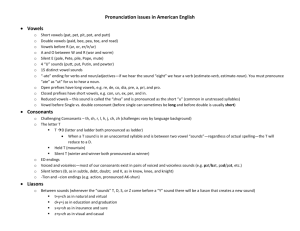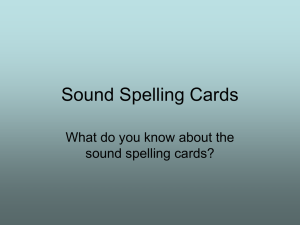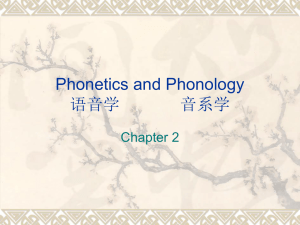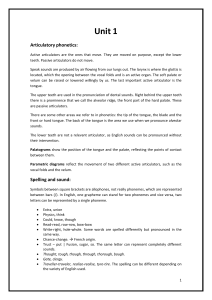Оқу-әдістемелік кешен
advertisement
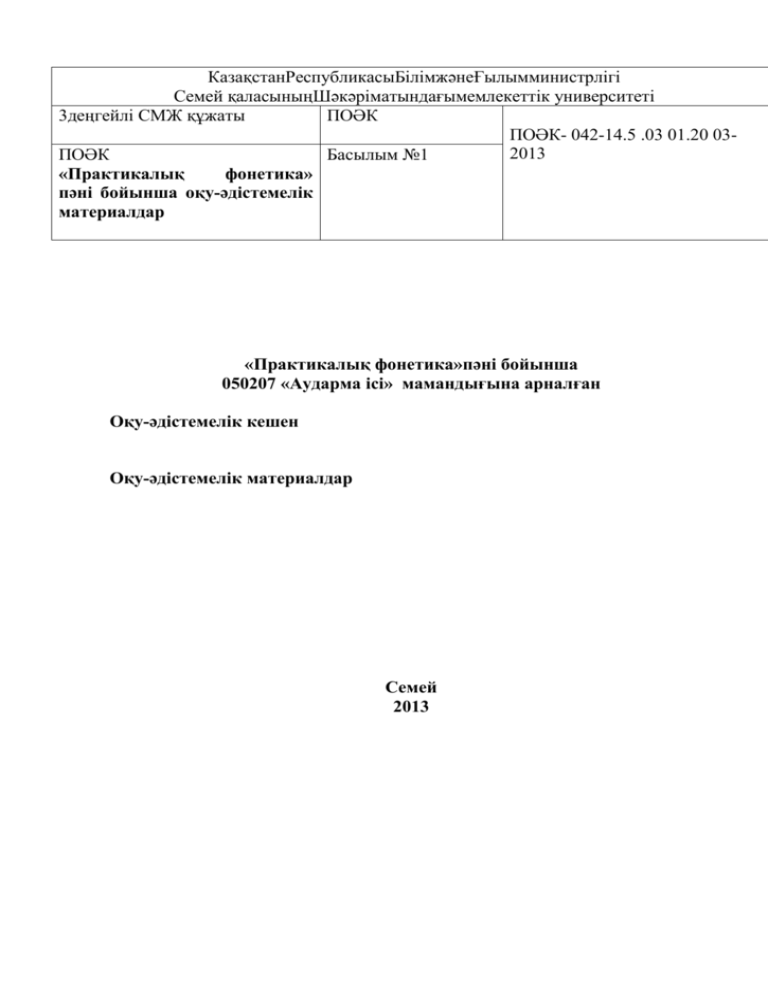
КазақстанРеспубликасыБілімжәнеҒылымминистрлігі Семей қаласыныңШәкәріматындағымемлекеттік университеті 3деңгейлі СМЖ құжаты ПОӘК ПОӘК- 042-14.5 .03 01.20 032013 ПОӘК Басылым №1 «Практикалық фонетика» пәні бойынша оқу-әдістемелік материалдар «Практикалық фонетика»пәні бойынша 050207 «Аударма ісі» мамандығына арналған Оқу-әдістемелік кешен Оқу-әдістемелік материалдар Семей 2013 ПОӘК 0414.5.03.01.20.20/03-2013 _____№ 1 басылым Мазмұны 1. Глоссарий 2. Практикалық сабақтар 2.Студенттің өздік жұмысы беттің 2 –сі ПОӘК 042-14.5.03.01.20.20/03-2013 _____№ 1 басылым беттің 3-сі 1. Глоссарий 2. Практикалық сабақтар Lesson 1-2 Organs of Speech 1. Active organs of Speech 2. Passive organs of Speech Aims 1. To study the organs of speech and their work. 2. To define the active and passive organs of speech. 3. To develop students’ pronunciation habits. 4. To understand four components: speech sounds, the syllabic structure of words, word stress and intonation. 5. To know the articulator or acoustic aspects and linguistic functions of the components. 6. To know the type of English pronunciation- Received pronunciation 7. To study the phonetic system of English. 8. To study syllable structure of English. 9. To study intonation, intonation patterns. 10.To pronounce isolated sounds 11.To pronounce sounds in different phonetic contexts. 12.To make a clear distinction between consonant and vowel sounds 13.To form a new habit of syllabic formation, weakening of unstressed vowels in connection with particular speech rhythms and intonation patterns 14.To understand phonetic mistakes 15.To develop professional skills and habits 16.To understand phonological mistakes 17.To study the articulation of each sound. 18.To practice sequences of sounds, combination of words, intonation groups, phrases Recommendations Active organs: Lips, tongue tip, blade, middle part, back part, soft palate, vocal cords. Passive organs: the teeth, the teeth ridge, the hard palate, the walls of the resonators. 1.Articulation exercises: a) Exercises for the opening of the mouth Keep the mouth closed with the lips pressed together. Drop the lower jaw as low as possible. The mouth should be wide open. Come back to the (a) position ПОӘК 042-14.5.03.01.20.20/03-2013 _____№ 1 басылым беттің 4-сі Continue practicing the exercise counting “two” b) Exercises for the lip Keep your lips pressed together Now open the mouth. The lips should be in their neutral position. Come back to the (a) position. Pronounce energetically [ m,m,m,] Continue practicing the exercise counting “two” [positions b,a] c)Exercise for the Tongue Open the mouth so that the separation of the jaws could be considerable and you could see the tongue. Put the tip of the tongue against the lower teeth. Now press it against the upper teeth. The position of the mouth is wide open, so that you can see the tongue. Put the tip of the tongue close to the edge of the upper teeth or even project it very slightly b/n the teeth. Questions 1. The direction of the air stream released from the lungs 2. Three different states of the vocal cords 3. The position of the soft palate 4. The parts of the palate 5. The parts of the tongue 6. The passive and active organs of speech Literature: 1.Y.M.Merkulova. English for university students. Introductiontophonetics. 2. Соколова М.А. Практическая фонетика английского языка. 3.Аракин В.Д. Практический курс английского языка, 1 курс 4. Колыхалова О.А. Учитесь говорить по-английски Москва, 1998 5.Лебединская Б.Я. Практикум по английскому языку, Москва 2000 6. Корчажкина О.М., Тихонова Р.М., Мои любимые звуки, Москва, 1996 Lesson 3-4-5 The speech sounds and phonemes, sounds, vowels and consonants. 1. Definition of allophone. 2. The functions of allophone 3. Definition of Phoneme. 4. The speech sounds. 5. Definition of Consonant Sound 6. Definition of Vowel sound Aims: ПОӘК 042-14.5.03.01.20.20/03-2013 _____№ 1 басылым беттің 5-сі 1. To understand four components: speech sounds, the syllabic structure of words, word stress and intonation. 2.To know the articulator or acoustic aspects and linguistic functions of the components. 3.To know the type of English pronunciation- Received pronunciation 4.To study the phonetic system of English. Questions: 1. 2. 3. 4. 5. Give the definitions of Vowels Allophone Phoneme Consonant Recommendations: 1. Define every type of sounds. 2. Enumerate the consonant and vowel groups Vowels are voiced sounds produced without any obstruction in the supra-glottal cavities and no noise component. Consonant-a kind of noise producing obstruction is formed in the supra-glottal cavities. Such sounds may be pronounced with or without vocal cords vibration. Literature: 1.Y.M.Merkulova. English for university students. Introductiontophonetics. 2. Соколова М.А. Практическая фонетика английского языка. 3.Аракин В.Д. Практический курс английского языка, 1 курс 4. Колыхалова О.А. Учитесь говорить по-английски Москва, 1998 5.Лебединская Б.Я. Практикум по английскому языку, Москва 2000 6. Корчажкина О.М., Тихонова Р.М., Мои любимые звуки, Москва, 1996 Lesson 6. Consonants 1. Classification of Consonants. ПОӘК 042-14.5.03.01.20.20/03-2013 _____№ 1 басылым беттің 5-сі Principles of Classification. Aims: 1. To study the phonetic system of English 2. To pronounce isolated sounds 3. To pronounce sounds in different phonetic contexts. 4. To make a clear distinction between consonant and vowel sounds 5. To study the articulation of each sound Questions 1. What is a consonant sound? 2. How do the consonants change on the articulatory level? 3. What are the 2 consonant classes according to the degree of noise? 4. What is the function of the vocal cords in the production of voiced and voiceless noise consonants? 5. How does the degree of noise vary because of the force of articulation? Recommendations: 1. Make the sound –p –strong and aspirated 2. Make the sound –t- strong and aspirated 3. Make the sound- k- strong and aspirated 4. Define the stop according to the place of articulation. 5. Think of word pairs illustrating the pronunciation of the final voicelessvoiced stops. Noise Consonants. According to the work of the Vocal Cords they may be voiceless [p,t, k, f, s, ]and voiced [b,d,g,v,z,] According to the mmaner of articulation consonants may be of 4 groups 1. Occlusive 2. Constrictive 3. Occlusive-constricitve 4. Rolled According to the position of the active organ of speech consonants may be : 1. Labial (bilabial and labio-dental) 2. Lingual may be : fore-lingual, medio-lingual and back-lingual Fore-lingual may be : apical, dorsal, cacuminal Literature:1.Y.M.Merkulova. English for university students. Introductiontophonetics. 2. Соколова М.А. Практическая фонетика английского языка. 3.Аракин В.Д. Практический курс английского языка, 1 курс 4. Колыхалова О.А. Учитесь говорить по-английски Москва, 1998 5.Лебединская Б.Я. Практикум по английскому языку, Москва 2000 6. Корчажкина О.М., Тихонова Р.М., Мои любимые звуки, Москва, 1996 ПОӘК 042_____№ 1 басылым 14.5.03.01.20.20/03-2013 беттің 6-сы Lesson 7-8 Consonants. 1. According to the degree of noise 2. According to the manner of articulation 3. According to the place of articulation. Aims: 1. To study the phonetic system of English. 2. 3. 4. 5. To pronounce isolated sounds To pronounce sounds in different phonetic contexts. To make a clear distinction between consonant and vowel sounds To study the articulation of each sound. Questions: 1. 2. 3. 4. 5. How does the position of the soft palate determine the quality of a sonorant? Define every type of obstruction. Why are plosives called “stops”? How else are constrictive noise consonants called and why? How do the fricatives vary in the work of the vocal cords and in the degree of force of articulation? 6. How are the constrictive sonorants made? 7. What is a sonorant? 8. What are the 4 groups of consonants according to the manner of articulation? 9. What consonant sounds are called “occlusive”? 10.What consonant sounds are called “constrictive”? 11.What consonants sounds are occlusive-occlusive? Recommendations: 1.Suppose your fellow student pronounces the Russian -x- instead of the English –h. Keeping in mind what you know about the articulation of the English sound tell him how to change the articulation. 2.Suppose your fellow student palatizes fricatives. 3.Define consonants according to the principles of classification. ПОӘК 042-14.5.03.01.20.20/03-2013 _____№ 1 басылым беттің 7-сі 4.Speak about the voicing of sonorants. 5.Speak about the length of sonorants. Literature: 1.Y.M.Merkulova. English for university students. Introductiontophonetics. 2. Соколова М.А. Практическая фонетика английского языка. 3.Аракин В.Д. Практический курс английского языка, 1 курс 4. Колыхалова О.А. Учитесь говорить по-английски Москва, 1998 5.Лебединская Б.Я. Практикум по английскому языку, Москва 2000 6. Корчажкина О.М., Тихонова Р.М., Мои любимые звуки, Москва, 1996 Lesson 9. Modification of consonants in connected speech. 1.assimilation. 2.Direction of assimilation 3.Degree of completeness. 4. Degree of stability. Aims 1.to study the phonetic system of English 2.to pronounce isolated sounds. 3.to pronounce sounds in different phonetic contexts. 4.to make a clear distinction between consonants and vowel sounds. 5.to study the articulation of each sound. Questions: 1.What is assimilation? 2.Give 3 examples illustrating different degrees of assimilation. 3.What is the difference between progressive and regressive assimilation? 4.What features of the articulation of a consonant may be affected by assimilation? Recommendations 1.Assimilation is a process of alteration of speech sounds as a result of one of the sounds becomes fully or partially similar to the adjoining sound. Types of assimilation can be distinguished according to: 1.direction (2) degree of completeness (3) degree of stability. 1.Direction of assimilation: progressive, regressive, reciprocal. ПОӘК 042-14.5.03.01.20.20/03-2013 _____№ 1 басылым беттің 8-сі 2.Degree of completeness: complete, incomplete. 3.Degree of stability: obligatory, historical Define consonants according to principles of classification. Literature: 1.Y.M.Merkulova. English for university students. Introductiontophonetics. 2. Соколова М.А. Практическая фонетика английского языка. 3.Аракин В.Д. Практический курс английского языка, 1 курс 4. Колыхалова О.А. Учитесь говорить по-английски Москва, 1998 5.Лебединская Б.Я. Практикум по английскому языку, Москва 2000 6. Корчажкина О.М., Тихонова Р.М., Мои любимые звуки, Москва, 1996 Lesson 10. Modification of consonants in connected speech 1.Consonants influences consonant 2.Voicing or Devoicing. Aims 1.to study the phonetic system of English 2.to pronounce isolated sounds 3.to pronounce sounds in different phonetic contexts. 4.to make a clear distinction between consonant and vowel sounds. Questions 1. What are the differences between the allophone and the principal one? 2. Transcribe and pronounce the given words and say what type of assimilation? (train, quarter, swallow). 3. Transcribe the words, underline the consonants affected by assimilation? (white, thorn, although, breadth). Recommendations 1. Give examples illustrating different types of assimilation. 2. Transcribe the words, underline the consonants affected by assimilation. 3. Pronounce the words and write the phonetic symbol which represents the sounds. 4. Transcribe and read the words. Literature: 1.Y.M.Merkulova. English for university students. Introductiontophonetics. 2. Соколова М.А. Практическая фонетика английского языка. 3.Аракин В.Д. Практический курс английского языка, 1 курс 4. Колыхалова О.А. Учитесь говорить по-английски Москва, 1998 5.Лебединская Б.Я. Практикум по английскому языку, Москва 2000 6. Корчажкина О.М., Тихонова Р.М., Мои любимые звуки, Москва, 1996 ПОӘК 042-14.5.03.01.20.20/03-2013 _____№ 1 басылым беттің 9-сы Lesson 11: Modification of consonants in connected speech 1.The reduction of consonant clusters (elision) 2. Non-obligatory assimilations of fluent colloquial speech Aims 1. To study the phonetic system of English 2. To pronounce isolated sounds 3. To pronounce sounds in different phonetic contexts. 4. To make a clear distinction between consonant and vowel sounds 5. To study the articulation of each sound Questions1. What allophone of the phoneme (d) is used within the words- drop, drug? 2.What articulatory features of the sonorant (1) within word –flower are affected by the assimilation? Which consonant within the word-clock is affected by assimilation? Recommendations 1.Give examples illustrating different types of assimilation. Transcribe the words, underline the consonants affected by assimilation. 3.Pronounce the words and write the phonetic symbol which represents the sounds. 4.Transcribe and read the words. Literature: 1.Y.M.Merkulova. English for university students. Introductiontophonetics. 2. Соколова М.А. Практическая фонетика английского языка. 3.Аракин В.Д. Практический курс английского языка, 1 курс 4. Колыхалова О.А. Учитесь говорить по-английски Москва, 1998 5.Лебединская Б.Я. Практикум по английскому языку, Москва 2000 6. Корчажкина О.М., Тихонова Р.М., Мои любимые звуки, Москва, 1996 Lesson 12-13. Fundamental consonant allophones. 1. Noise consonants. 2. Constrictive consonants. 3. Sonorants. Aims. 1.to study the phonetic system of English 2.to pronounce isolated sounds. To pronounce sounds in different phonetic contexts. To make a clear distinction between consonant and vowel sounds. Questions 1. What allophones of English stops are used before the nasal sonorants? ПОӘК 042-14.5.03.01.20.20/03-2013 _____№ 1 басылым беттің 10-сы 2. In what clusters do the plosionless allophones of the stops occur? 3. Why is it important to know and be able to pronounce the subsidiary allophones of the phonemes? Recommendations [p] and [b] become labio-dental when followed by [f] or [v] eg: hopeful, subvert. 2.the position of lips depends on the vowel followed by [p] [b] 3.before front, high or mid-open vowels [p] and [b] sound a bit cleaner than before back vowels e.g. : peak, big. 4.In word final position the lenis [b] is only partially voiced, e.g. :cab. 1,Noise consonants [t] and [d] 1.Dental allophones of [t,d] are used before [ө], e.g. : eighth 2. post alveolar allophones of [t,d] are used when they are followed by [r] e.g. : trip, drug. 3. the position of the lips depends on the vowel or the sonorant [w] following [t] or [d] Read the dialogues. Learn them. Act out the dialogues. 1.In a restaurant. 2.an interesting film. 3.busy in the kitchen. 4.wedding not for me. Literature: 1.Y.M.Merkulova. English for university students. Introductiontophonetics. 2. Соколова М.А. Практическая фонетика английского языка. 3.Аракин В.Д. Практический курс английского языка, 1 курс 4. Колыхалова О.А. Учитесь говорить по-английски Москва, 1998 5.Лебединская Б.Я. Практикум по английскому языку, Москва 2000 6. Корчажкина О.М., Тихонова Р.М., Мои любимые звуки, Москва, 1996 Lesson 14. Vowels. 1.Monophthongs 2.Diphthongs. 3.Diphthongoids. Aims: 1.to study the phonetic system of English. 2.to pronounce isolated sounds. 3. to pronounce sounds in different phonetic contexts. 4.to make a clear distinction between consonant and vowel sounds. 5. to study the articulation of each sound. ПОӘК 042-14.5.03.01.20.20/03-2013 _____№ 1 басылым беттің 11-сі Questions 1.Give examples where (a) is the longest. 2.What articulatory features of the vowel differentiate the words –port-pot? 3.What is the difference between the neutral vowel in the final and in the non-final position? 4.What makes central and front vowels different? 5. What are the differences between free and checked vowels? Recommendations: 1.Give examples of vowels to each category. On the articulatory level the description of vowels notes changes. a. In the stability of articulation b. In the tongue position. c. In the lip position. d. In the character of the vowel end. 2.Give examples of monophthongs, diphthongs and diphthongoids. 1.All English vowels are divided into :monophthongs, diphthongs and diphthongoids. 2.tongue position: a front vowel, a front-retracted, central back-advanced, close, open, broad and narrow. 3.lip position: unrounded, rounded 4.Character of vowel end: checked, free 5. Vowel length: long, short. Literature: 1.Y.M.Merkulova. English for university students. Introductiontophonetics. 2. Соколова М.А. Практическая фонетика английского языка. 3.Аракин В.Д. Практический курс английского языка, 1 курс 4. Колыхалова О.А. Учитесь говорить по-английски Москва, 1998 5.Лебединская Б.Я. Практикум по английскому языку, Москва 2000 6. Корчажкина О.М., Тихонова Р.М., Мои любимые звуки, Москва, 1996 Lesson 15-16 Vowels. 1.tongue position 2.Lip position 3.Character of the vowel end. Aims: 1.to study the phonetic system of English. 2.to pronounce isolated sounds. 3.to pronounce sounds in different phonetic contexts. 4.to make a clear distinction between consonant and vowel sounds. 5.to study the articulation of each sound. ПОӘК 042-14.5.03.01.20.20/03-2013 _____№ 1 басылым беттің 11-сі Questions: 1.What articulation features of the vowel sounds differentiate the meanings of the words –bet-bought-boat, got-goat? 2.What articulation features of the vowel sounds differentiate the meanings of the words-pierce-peace? 3.What articulation features of the vowel sounds differentiate the meanings of the words-shoe-sure? 4.Think of word sequences to illustrate the differences in vowel. 5.What is similar in the articulation of the vowels (u) and (i:)? 6.In what position is the vowel (u) the shortest? 7.Why is the vowel (u) called back-advanced? Recommendations: 1.Give examples of vowels to each category. On the articulatory level the description of vowels notes changes a.in the stability of articulation b.in the tongue position c.in the lip position d.in the character of the vowel end. 2.Give examples of monophthongs, diphthongs and diphthongoids. 6.All English vowels are divided into: monophthongs, diphthongs and diphthongoids. 7.Tongue position: a front vowel, a front-retracted, central back-advanced, close, open, broad, narrow. 8.Character of vowel end: checked, free 10.Vowel length: long, short Literature: 1.Y.M.Merkulova. English for university students. Introductiontophonetics. 2. Соколова М.А. Практическая фонетика английского языка. 3.Аракин В.Д. Практический курс английского языка, 1 курс 4. Колыхалова О.А. Учитесь говорить по-английски Москва, 1998 5.Лебединская Б.Я. Практикум по английскому языку, Москва 2000 6. Корчажкина О.М., Тихонова Р.М., Мои любимые звуки, Москва, 1996 Lesson 17. Vowels 1.Modification of Vowels in connected Speech 2.Reduction 3.Strong and weak forms Aims. 1.to study the phonetic system of English 2.to pronounce isolated sounds ПОӘК 042-14.5.03.01.20.20/03-2013 _____№ 1 басылым беттің 12-сі 3.to pronounce sounds in difference different phonetic contexts 4.to make a clear distinction between consonant and vowel sounds 5. to study the articulation of each sound Questions 1.What phenomenon is called –reduction? 2.What degrees of reduction do you know? 3.Whithin what segments of speech is reduction realized? Recommendations 1.Give examples of vowels to each category. On the articulatory level the description of vowels notes changes a. In the stability of articulation. b. In the tongue position. c. In the lip position d. In the character of the vowel end. 2.Give examples of monophthongs, diphthongs and diphthongoids. 11. all English vowels are divided into: monophthongs, diphthongs and diphthongoids. 12.Tongue position: a front vowel, a front-retracted, central back-advanced, close, open, broad, narrow. 13.Lip position: unrounded, rounded 14.Character of vowel end: checked, free 15.Vowel length: long, short 3.Transcribe and read the sentences. 4.Give examples of modification of vowels in connected speech. Literature: 1.Y.M.Merkulova. English for university students. Introductiontophonetics. 2. Соколова М.А. Практическая фонетика английского языка. 3.Аракин В.Д. Практический курс английского языка, 1 курс 4. Колыхалова О.А. Учитесь говорить по-английски Москва, 1998 5.Лебединская Б.Я. Практикум по английскому языку, Москва 2000 6. Корчажкина О.М., Тихонова Р.М., Мои любимые звуки, Москва, 1996 Lesson 18. Syllable. 1.Syllable formation 2.Syllable division. Aims: 1.to know the articulatory or acoustic aspects and linguistic functions of the components 2.to know the type of English pronunciation –Received Pronunciation. 3.to study the phonetic system of English. ПОӘК 042-14.5.03.01.20.20/03-2013 _____№ 1 басылым беттің 13-сі 4. To study syllabic structure of English 5. Form a new habit of syllabic formation, weakening of unstressed vowels in connection with particular speech rhythms and intonation patterns. Questions: 1.What is a syllable? 2.What sounds can form the peak of a syllable? 3.What sonorous sounds are syllabic? 4.When does the sonorant lose its syllabic character? 5. What is the generalized formula of a syllable structure. Recommendations: 1.Be sure to make the final sonorants –l-m-n- with preceding consonants syllabic. 2.Make vowels in stressed syllables checked by passing over to the articulation of the following consonants as quickly as possible. Literature: 1.Y.M.Merkulova. English for university students. Introductiontophonetics. 2. Соколова М.А. Практическая фонетика английского языка. 3.Аракин В.Д. Практический курс английского языка, 1 курс 4. Колыхалова О.А. Учитесь говорить по-английски Москва, 1998 5.Лебединская Б.Я. Практикум по английскому языку, Москва 2000 6. Корчажкина О.М., Тихонова Р.М., Мои любимые звуки, Москва, 1996. Lesson 19. Word stress. 1.Manifestation of word stress and its linguistic function. 2.the degrees and the position of word stress. 3.the distinctive function of word stress. Aims: 1.to know the articulatory or acoustic aspects and linguistic functions of the components 2.to know the type of English pronunciation –Received Pronunciation. 3.to study the phonetic system of English 4.Form a new habit of syllabic formation, weakening of unstressed vowels in connection with particular speech rhythms and intonation patterns. Questions: 1.What factors create the effect of stress in the English words- torment (n)- torment (v)- concert (n)-concert (v)? 2.How is pitch component manifested in English word stress? 3.What is difference in the accentual patterns of compound nouns, adjectives, verbs? 4.what kind of accentual oppositions are capable of differentiating the meaning? Recommendations: ПОӘК 042-14.5.03.01.20.20/03-2013 _____№ 1 басылым беттің 14-сі 1. Give a series of examples to illustrate the fact the qualitative modification of unstressed vowels is not obligatory in English. 2. Define word stress of the words in respect of its position: finish, together, family, apologize, educated. 3.Compare the accentual patterns of words: unusual-unshaven. 3. Literature: 4. 1.Y.M.Merkulova. English for university students. Introductiontophonetics. 5. 2. Соколова М.А. Практическая фонетика английского языка. 6. 3.Аракин В.Д. Практический курс английского языка, 1 курс 7. 4. Колыхалова О.А. Учитесь говорить по-английски Москва, 1998 5.Лебединская Б.Я. Практикум по английскому языку, Москва 2000 8. 6. Корчажкина О.М., Тихонова Р.М., Мои любимые звуки, Москва, 1996. Lesson 20. Intonation. 1.Manifestation of intonation and its linguistic function. 2.Basic intonation patterns. 3.The anatomy of intonation patterns. 4.The nucleus. Types of nuclei. 5.The tail. The head. Aims: 1. To understand four components: speech sounds, the syllabic structure of words, structure of words, word stress, intonation. 2.to know the articulatory or acoustic aspects and linguistic functions of the components 3.to know the type of English pronunciation –Received Pronunciation. 4.to study the phonetic system of English 5.to study syllable structure of English 6. to study intonation. Questions: 1.What pitch levels are generally distinguished? 2.What is a pitch range? What pitch ranges are called normal, wide, narrow? 3. What is the nucleus? 4. What section of intonation pattern is called the Head? 5. What is the main difference between the falling, stepping and scandent heads? 6. What kind of head is called sliding? 7. What heads are called level? Recommendations: 1.Reanscribe and intone the following disjunctive questions to predicative structures in the plural. Read them aloud. 2. Transcribe, intone, and read dialogues. ПОӘК 042-14.5.03.01.20.20/03-2013 _____№ 1 басылым беттің 15-сі a. Elise’s Hair is green. b. Looking for something pretty. c. Make up your own story of the same kind. Mark stresses and tunes. Practise the text for text reading. d. Observe the intonation. e. Concentrate your attention on the intonation of the reply. f. Memorize the dialogues. g. Make up your dialogue of the same kind. 2. 3. 4. 5. 6. Literature: 1.Y.M.Merkulova. English for university students. Introductiontophonetics. 2. Соколова М.А. Практическая фонетика английского языка. 3.Аракин В.Д. Практический курс английского языка, 1 курс 4. Колыхалова О.А. Учитесь говорить по-английски Москва, 1998 5.Лебединская Б.Я. Практикум по английскому языку, Москва 2000 6. Корчажкина О.М., Тихонова Р.М., Мои любимые звуки, Москва Lessons 21-22 Classification of intonation patterns. 1.intonation patterns and meanings. 2.Sentence types. 3.Intonation patterns and sentence types. Aims: 1. To understand four components: speech sounds, the syllabic structure of words, structure of words, word stress, intonation. 2.to know the articulatory or acoustic aspects and linguistic functions of the components 3.to know the type of English pronunciation –Received Pronunciation. 4.to study the phonetic system of English 5.to study syllable structure of English 6. to study intonation. Questions: 1.What attitudes of a speaker are expressed by the Low Level Head+the Low Fall? 2.Why can we call the Stepping Head emphatic? 3.How does a speaker sound when he uses the scandent Head+ the Low Fall? 4. Define the attitudes expressed by the High Pre-Nucleus+ the Low Fall? Recommendations: 1.transcribe and intone the following disjunctive questions to predicative structures in the plural. Read them aloud. 2.Transcribe, intone and read dialogues. ПОӘК 042-14.5.03.01.20.20/03-2013 _____№ 1 басылым беттің 16-сы a. Elise’s Hair is green. b. Looking for something pretty. c. Make up your own story of the same kind. Mark stresses and tunes. Practise the text for text reading. d. Observe the intonation. e. Concentrate your attention on the intonation of the reply. f. Memorize the dialogues. g. Make up your dialogue of the same kind. 2. Literature: 1.Y.M.Merkulova. English for university students. Introductiontophonetics. 2. Соколова М.А. Практическая фонетика английского языка. 3.Аракин В.Д. Практический курс английского языка, 1 курс 4. Колыхалова О.А. Учитесь говорить по-английски Москва, 1998 5.Лебединская Б.Я. Практикум по английскому языку, Москва 2000 6. Корчажкина О.М., Тихонова Р.М., Мои любимые звуки, Москва Lesson 23-24-25. Intoning. Sequence of tones. 1.Parentheses 2. Simple sentences (Statements: adverbial Phrases, Enumeration) 3.questions (Disjunctive, Alternative questions, Imperatives.) 4. Independent Elements of the sentence (Direct address, parentheses, author’s words) 5.Compound and complex sentences. Aims: 1. To understand four components: speech sounds, the syllabic structure of words, structure of words, word stress, intonation. 2.to know the articulatory or acoustic aspects and linguistic functions of the components 3.to know the type of English pronunciation –Received Pronunciation. 4.to study the phonetic system of English 5.to study syllable structure of English 6. to study intonation. Questions: 1.what determines the choice of the final terminal tone? 2.Explain the difference between the meaning of the sentences. 3.Explain the use of the low rising tone in the sentences. 4.What do you think parenthetical words and phrases do not always form intonation groups at the beginning of the sentence? 5. What does the intonation of compound sentences depend on? 6. what is the difference in intonation in short and fairy long author’s words at the end of the sentence? ПОӘК 042-14.5.03.01.20.20/03-2013 _____№ 1 басылым беттің 17-сі Recommendations: 1. Speak o different ways of pronunciation of imperatives including a tag questions. 2. Read and act out the dialogue: were you at home last night? 3. Learn the dialogues by heart. 4. Dramatize the dialogues. 1.When did Socrates live? 2. He has one rabbit at home. 5. Act out the dialogues. 6. Mark the stresses and tunes in the sentences. 7. Find examples from any book you read illustrating the sequence of tones. Literature: 1.Y.M.Merkulova. English for university students. Introductiontophonetics. 2. Соколова М.А. Практическая фонетика английского языка. 3.Аракин В.Д. Практический курс английского языка, 1 курс 4. Колыхалова О.А. Учитесь говорить по-английски Москва, 1998 5.Лебединская Б.Я. Практикум по английскому языку, Москва 2000 6. Корчажкина О.М., Тихонова Р.М., Мои любимые звуки, Москва Lesson 26-27. Making stresses. Sentence stress. 1. Manifestation of sentence stress. 2. Types of sentence stress. 3. The distinctive function of sentence stress. Aims: 1. To understand phonological mistakes. 2.To understand phonetic mistakes. 3.To develop professional skills and habits. 4. to practice sequences od sounds, combination of words, intonation groups, phrases. Questions: 1.How is the prominence of words realized? 2.What is the main function of sentence stress? Which is the most prominent word in the sentences? 4.What is the difference between normal and logical stress? 5. In what way are the words in a sentence made prominent? Recommendations: When practicing reading think over every sentence. Analyse the context. Find and underline the communicative center in each phrase. Mark stresses and tunes. Be very careful to weaken and obscure unstressed words properly. Try to make your reading and speech convincing and expressive enough. 1. Adverbials, enumeration, disjunctive questions, alternative questions. 2. Commands 3. Direct address 4. Parentheses ПОӘК 042-14.5.03.01.20.20/03-2013 _____№ 1 басылым беттің 18-сі Literature: 1.Y.M.Merkulova. English for university students. Introductiontophonetics. 2. Соколова М.А. Практическая фонетика английского языка. 3.Аракин В.Д. Практический курс английского языка, 1 курс 4. Колыхалова О.А. Учитесь говорить по-английски Москва, 1998 5.Лебединская Б.Я. Практикум по английскому языку, Москва 2000 6. Корчажкина О.М., Тихонова Р.М., Мои любимые звуки, Москва Lesson 28-29. Tempo. Types and functions of pausation. 1. Tempo 2. Types and functions of pausation. Aims: . To understand phonological mistakes. 2.To understand phonetic mistakes. 3.To develop professional skills and habits. 4. to practice sequences od sounds, combination of words, intonation groups, phrases. Questions: 1.What is speech tempo? 2. What degrees of speech rate do you know? 3. What is the speed of any unstressed syllables preceding the stressed ones? 4.What determines the average of utterance? 5.How does the speed of utterance depend on the correlation of stressed and unstressed syllables? 6. how does a change in the rate of speech influence the length of English vowels? 7. Does tempo vary according to the emotional state of the speaker? 8.What is the function of pausation? 9. Do pauses differ in length? 10. What are the main kinds of pauses in English? Recommendations: 1.Say what you know about rhythmical variations of stress in compounds (adjective-noun; adverb-adjective, adverb-verb) when they are used in connected speech: -when final, and immediately preceded by a stress, -when a stress immediately follows the word. 2.Give your own examples using the following words: fourteen, good-natured, well-known, put off, look through ПОӘК 042-14.5.03.01.20.20/03-2013 3. 4. 5. 6. 7. 8. _____№ 1 басылым беттің 19-сы Learn the situations by heart. Listen to the following phrases and imitate the model on the tape. Transcribe the extracts. Analyze it. Ex. 2. P. 376. Listen to the tape. Imitate the reading task 3 p 377 Listen carefully to the dialogue. Listen to the series of the sentences, repeat the sentences in the intervals. Literature: 1.Y.M.Merkulova. English for university students. Introductiontophonetics. 2. Соколова М.А. Практическая фонетика английского языка. 3.Аракин В.Д. Практический курс английского языка, 1 курс 4. Колыхалова О.А. Учитесь говорить по-английски Москва, 1998 5.Лебединская Б.Я. Практикум по английскому языку, Москва 2000 6. Корчажкина О.М., Тихонова Р.М., Мои любимые звуки, Москва Lesson 30. Rhythm 1.Rhythm. Aims: 1.To understand phonological mistakes. 2.To understand phonetic mistakes. 3.To develop professional skills and habits. 4. to practice sequences od sounds, combination of words, intonation groups, phrases. Questions: 1.What is speech rhythm? 2.What are the characteristic features of English rhythm? 3.What is a rhythmic group? 4.How are unstressed syllables that follow the stressed one pronounced? 5.What is the influence of rhythm on unstressed syllables? 6.Should there be any pause or break within an intonation group? Recommendations: 1.Say what you know about rhythmical variations of stress in compounds (adjective-noun; adverb-adjective, adverb-verb) when they are used in connected speech: -when final, and immediately preceded by a stress, -when a stress immediately follows the word. 2.Give your own examples using the following words: fourteen, good-natured, well-known, put off, look through ПОӘК 042-14.5.03.01.20.20/03-2013 _____№ 1 басылым беттің 20-сы 3.Learn the situations by heart. 4. Listen to the following phrases and imitate the model on the tape. 5. Transcribe the extracts. Analyze it. Ex. 2. P. 376. 6. Listen to the tape. Imitate the reading task 3 p 377 7. Listen carefully to the dialogue. 8.Listen to the series of the sentences, repeat the sentences in the intervals Literature: 1.Y.M.Merkulova. English for university students. Introductiontophonetics. 2. Соколова М.А. Практическая фонетика английского языка. 3.Аракин В.Д. Практический курс английского языка, 1 курс 4. Колыхалова О.А. Учитесь говорить по-английски Москва, 1998 5.Лебединская Б.Я. Практикум по английскому языку, Москва 2000 6. Корчажкина О.М., Тихонова Р.М., Мои любимые звуки, Москва 3.Студенттердің өздік жұмысы 5.1. to study the organs of speech and their work. To define the active and passive organs of speech. Active organs: lips, tongue, tip, blade, middle part, back part, soft palate, vocal cords. Passive organs: the teeth, the teeth ridge, the hard palate, the walls of the resonators. 5.2. the speech sounds and phonemes, sounds, vowels and consonants. 5.3. modification of consonants in connected speech. Assimilation. 5.4. fundamental consonant allophones. 5.5. vowels. 5.6.syllable. word stress. Intonation. 5.7.classification of intonation patterns. 5.8. sequence of tones. Parentheses. 5.9.sentence stress. Tempo. Types and functions of pausation to learn the definition of Rhythm. Control work 1. Find the active organs of speech a)the teeth, hard palate b)teeth bridge, the teeth c)tongue, lips, palate 2. How many types of speech sounds are there in English? a)2 b)3 c)4 3. What is a consonant sound? a) it is a voiced sound produced without any obstruction in the supra- glottal cavities and consequently have no noise components. b) it is a sound produced with or without vocal cords vibration and have noise components ПОӘК 042-14.5.03.01.20.20/03-2013 _____№ 1 беттің 21-сі басылым c)it is the smallest contrastive language unit. 4.Find the voiced consonants a) p,t,k b)f,s,p c)b,d,g 5.What are the two consonant classes according to the degree of noise: a)occlusive, constrictive b)noise consonants, sonorants c)dental, alveolar 6.How many affricates are there in English? a)3 b)4 c)2 7.Find the examples which are accompanied by strong aspiration: a)speech, stop b)port, talk, take, Kate c)lip, cook 8.What consonants are accompanied by aspiration: a)b,d,g b)k,g c)p,t,k 9.Sonorous consonants are subdivided into: a)lenis, fortis b)voiced, voiceless c) nasal,oral 10. What is a vowel sound? a)it is a sound produced with or without vocal cords vibration. b)it is a voiced sound produced without any obstruction in the supra- glottal cavities and consequently have no noise components. c)various speech realizations of the phoneme. 11. Find the passive organs of speech: a)the vocal cords, the tongue b)the teeth, the hard palate c)the soft palate, the jaw 12.How many vowels are there in English? a)14 b)8 c)6 13.How are strong noise consonants produced? a)they are produced with relatively weak breath effort? b)they are produced with more muscular energy and stronger breath effort? c)when they are produced we hear voice. 14. How do English phoneticians call the weak consonants? a)voiced b)lenis c)fortis 15.Find the right transcription of words: yard, yellow, yield. 16. find the examples which contain affricates: a)photo, tango, banjo b)chain, jam c)rail, pain 17. Find the labio-dental consonants: a)k,g b)s,z c)f,v 18. What sonorous consonant does not occur in the word initial position? a)m b)n c)ng 19.What is assimilation? a)it is a process of alteration of speech sounds as a result of one of the sounds. b)it is a strong puff of breath in a voiceless interval after the explosion. c)it is a special prominence given to one or more words according to their relative importance in a sentence. 20.Find the right definition of –f, v ПОӘК 042-14.5.03.01.20.20/03-2013 a)forelingual, interdental _____№ 1 басылым b)fricative, dental беттің 22-сі c)forelingual, alveolar Control work 1. Name the active and passive organs of speech and their role in sound formation. 2. What is a consonant sound? 3. How do the consonant s change on the articulatory level? 4. How does the degree of noise vary because of the force of articulation. 5. What are the four groups of consonants according to the manner of articulation? 6. What articulatory features of the opposed consonants make the meaning of the following words different? Pea-fee, head-fed Theme-seem, thought-fought, place-plays 7.what is assimilation? 8.what similar assimilative changes do the allophones of the phonemes [t,d,n, l, s, z] 9. What allophones of English stops are used before the nasal sonorants? 10. Give examples to the consonant allophones. Control work. 1. What is a vowel sound? 2. Name groups of vowels according to the tongue position, lip position, vowel length. 3. What similarity can be traced in the articulation of the vowels [u], [a:], [e]. 4. What phenomenon is called “reduction”? 5. What’s word stress? Give examples. 6. What is a syllable? 7. What is intonation? Give examples. 8. What is a pre-head, head , nucleus, tail? 9. Give classification of intonation patterns. 10.What’s sentence stress? Give examples. Examination tasks Card 1 1. The organs of speech. The active and passive organs of speech. 2. The intonation of parentheses 3. Practical task ПОӘК 042-14.5.03.01.20.20/03-2013 _____№ 1 басылым беттің 23-сі Card 2. 1. The vowels of English. 2. Sentence stress. Logical stress 3. Practical task. Card 3. 1. Consonants of English 2. Sequence of tense 3. Practicsl task. Card 4. 1. Assimilation and adaptation of speech sounds. Elision. 2. Classification of intonation patterns. 3. Practical task. Card 5. 1.Syllable . word stress. 2.Intonation. 3.practical task. Card 6 1. Phonetic phenomenon. Palatalization, nasal plosion, loss plosion, aspiration 2. Modification of vowels in connected speech 3. Practical task Card 7. 1.intonation. nuclear tone. 2.intonation of statements. 3. Practical task Card 8. 1. Classification of consonants according to the degree of noise. Manner of articulation. 2. Group of vowels according to the tongue position, lip position, vowel length. 3. Practical task. Card 9. 1.syllable, stress, tone, speech melody. 2.intonation of imperatives. 3.practical task. ПОӘК 042-14.5.03.01.20.20/03-2013 _____№ 1 басылым беттің 24-сі Card 10 1.intonation of general questions. 2.articulation of vowels 3.practical task Card 11 1.intonation of disjunctive questions 2.articulation of consonants 3.practical task Card 12. 1.intonation of alternative questions. 2. classification of vowels. 3.practical task Card 13. 1.intonantion of special questions. 2.classification of consonants. 3.practical task Card 14. 1. Intonation of enumeration. 2. Assimilation and adaptation of speech sounds. Elision. 3. Practical task Card 15. 1.intonation of a phoneme allophone and functions of allophones. 2.syllable, word stress, intonation. 3.practical task

